Marketing Cigarettes: Packaging, Labeling, and Consumer Perception
VerifiedAdded on 2023/01/20
|5
|1099
|76
Report
AI Summary
This report provides an analysis of cigarette marketing, focusing on the impact of packaging and labeling on consumer perception and purchase decisions. It examines how labeling creates health awareness, influences buying behavior, and informs about product variants. The report compares cigarette packaging and labeling regulations in Australia and India, highlighting differences in color usage and warning logos. Australia emphasizes dull colors to deter young consumers, while India mandates prominent written warnings. The comparison reveals that Australia's approach is more market-centric, while India's focuses on consumer awareness. The report references several academic sources to support its findings, offering insights into effective marketing strategies and the implications of tobacco industry practices.
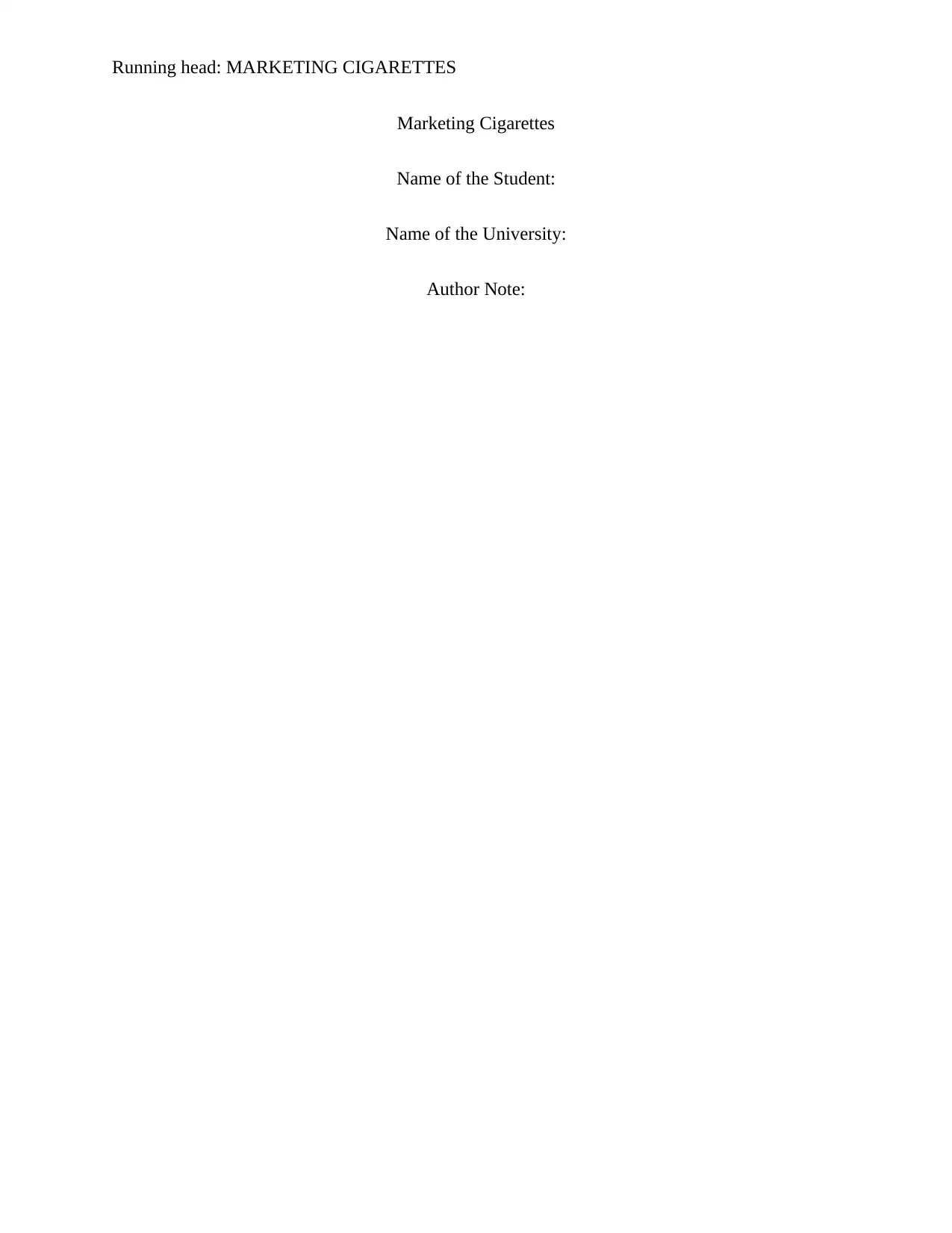
Running head: MARKETING CIGARETTES
Marketing Cigarettes
Name of the Student:
Name of the University:
Author Note:
Marketing Cigarettes
Name of the Student:
Name of the University:
Author Note:
Paraphrase This Document
Need a fresh take? Get an instant paraphrase of this document with our AI Paraphraser
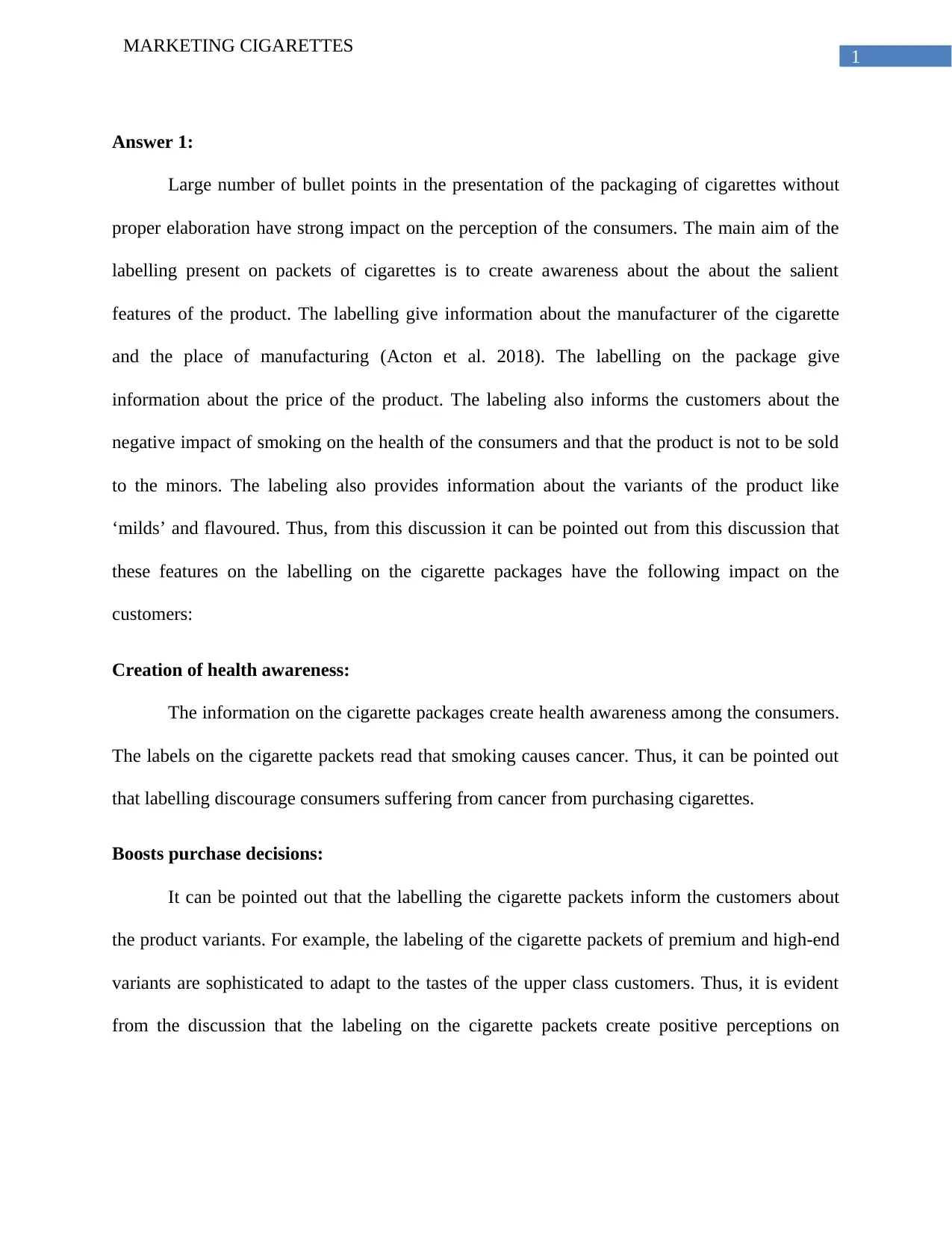
1
MARKETING CIGARETTES
Answer 1:
Large number of bullet points in the presentation of the packaging of cigarettes without
proper elaboration have strong impact on the perception of the consumers. The main aim of the
labelling present on packets of cigarettes is to create awareness about the about the salient
features of the product. The labelling give information about the manufacturer of the cigarette
and the place of manufacturing (Acton et al. 2018). The labelling on the package give
information about the price of the product. The labeling also informs the customers about the
negative impact of smoking on the health of the consumers and that the product is not to be sold
to the minors. The labeling also provides information about the variants of the product like
‘milds’ and flavoured. Thus, from this discussion it can be pointed out from this discussion that
these features on the labelling on the cigarette packages have the following impact on the
customers:
Creation of health awareness:
The information on the cigarette packages create health awareness among the consumers.
The labels on the cigarette packets read that smoking causes cancer. Thus, it can be pointed out
that labelling discourage consumers suffering from cancer from purchasing cigarettes.
Boosts purchase decisions:
It can be pointed out that the labelling the cigarette packets inform the customers about
the product variants. For example, the labeling of the cigarette packets of premium and high-end
variants are sophisticated to adapt to the tastes of the upper class customers. Thus, it is evident
from the discussion that the labeling on the cigarette packets create positive perceptions on
MARKETING CIGARETTES
Answer 1:
Large number of bullet points in the presentation of the packaging of cigarettes without
proper elaboration have strong impact on the perception of the consumers. The main aim of the
labelling present on packets of cigarettes is to create awareness about the about the salient
features of the product. The labelling give information about the manufacturer of the cigarette
and the place of manufacturing (Acton et al. 2018). The labelling on the package give
information about the price of the product. The labeling also informs the customers about the
negative impact of smoking on the health of the consumers and that the product is not to be sold
to the minors. The labeling also provides information about the variants of the product like
‘milds’ and flavoured. Thus, from this discussion it can be pointed out from this discussion that
these features on the labelling on the cigarette packages have the following impact on the
customers:
Creation of health awareness:
The information on the cigarette packages create health awareness among the consumers.
The labels on the cigarette packets read that smoking causes cancer. Thus, it can be pointed out
that labelling discourage consumers suffering from cancer from purchasing cigarettes.
Boosts purchase decisions:
It can be pointed out that the labelling the cigarette packets inform the customers about
the product variants. For example, the labeling of the cigarette packets of premium and high-end
variants are sophisticated to adapt to the tastes of the upper class customers. Thus, it is evident
from the discussion that the labeling on the cigarette packets create positive perceptions on
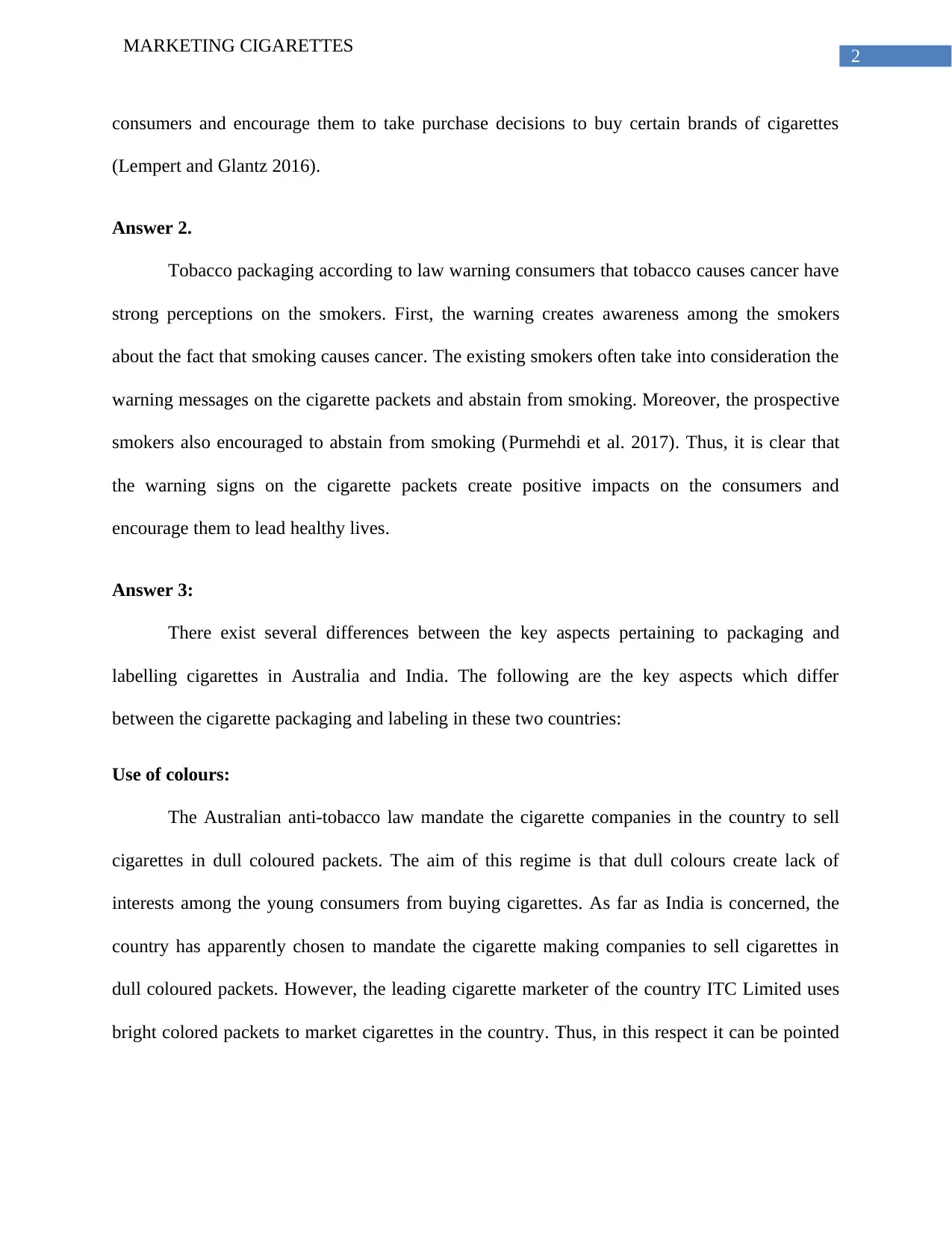
2
MARKETING CIGARETTES
consumers and encourage them to take purchase decisions to buy certain brands of cigarettes
(Lempert and Glantz 2016).
Answer 2.
Tobacco packaging according to law warning consumers that tobacco causes cancer have
strong perceptions on the smokers. First, the warning creates awareness among the smokers
about the fact that smoking causes cancer. The existing smokers often take into consideration the
warning messages on the cigarette packets and abstain from smoking. Moreover, the prospective
smokers also encouraged to abstain from smoking (Purmehdi et al. 2017). Thus, it is clear that
the warning signs on the cigarette packets create positive impacts on the consumers and
encourage them to lead healthy lives.
Answer 3:
There exist several differences between the key aspects pertaining to packaging and
labelling cigarettes in Australia and India. The following are the key aspects which differ
between the cigarette packaging and labeling in these two countries:
Use of colours:
The Australian anti-tobacco law mandate the cigarette companies in the country to sell
cigarettes in dull coloured packets. The aim of this regime is that dull colours create lack of
interests among the young consumers from buying cigarettes. As far as India is concerned, the
country has apparently chosen to mandate the cigarette making companies to sell cigarettes in
dull coloured packets. However, the leading cigarette marketer of the country ITC Limited uses
bright colored packets to market cigarettes in the country. Thus, in this respect it can be pointed
MARKETING CIGARETTES
consumers and encourage them to take purchase decisions to buy certain brands of cigarettes
(Lempert and Glantz 2016).
Answer 2.
Tobacco packaging according to law warning consumers that tobacco causes cancer have
strong perceptions on the smokers. First, the warning creates awareness among the smokers
about the fact that smoking causes cancer. The existing smokers often take into consideration the
warning messages on the cigarette packets and abstain from smoking. Moreover, the prospective
smokers also encouraged to abstain from smoking (Purmehdi et al. 2017). Thus, it is clear that
the warning signs on the cigarette packets create positive impacts on the consumers and
encourage them to lead healthy lives.
Answer 3:
There exist several differences between the key aspects pertaining to packaging and
labelling cigarettes in Australia and India. The following are the key aspects which differ
between the cigarette packaging and labeling in these two countries:
Use of colours:
The Australian anti-tobacco law mandate the cigarette companies in the country to sell
cigarettes in dull coloured packets. The aim of this regime is that dull colours create lack of
interests among the young consumers from buying cigarettes. As far as India is concerned, the
country has apparently chosen to mandate the cigarette making companies to sell cigarettes in
dull coloured packets. However, the leading cigarette marketer of the country ITC Limited uses
bright colored packets to market cigarettes in the country. Thus, in this respect it can be pointed
⊘ This is a preview!⊘
Do you want full access?
Subscribe today to unlock all pages.

Trusted by 1+ million students worldwide
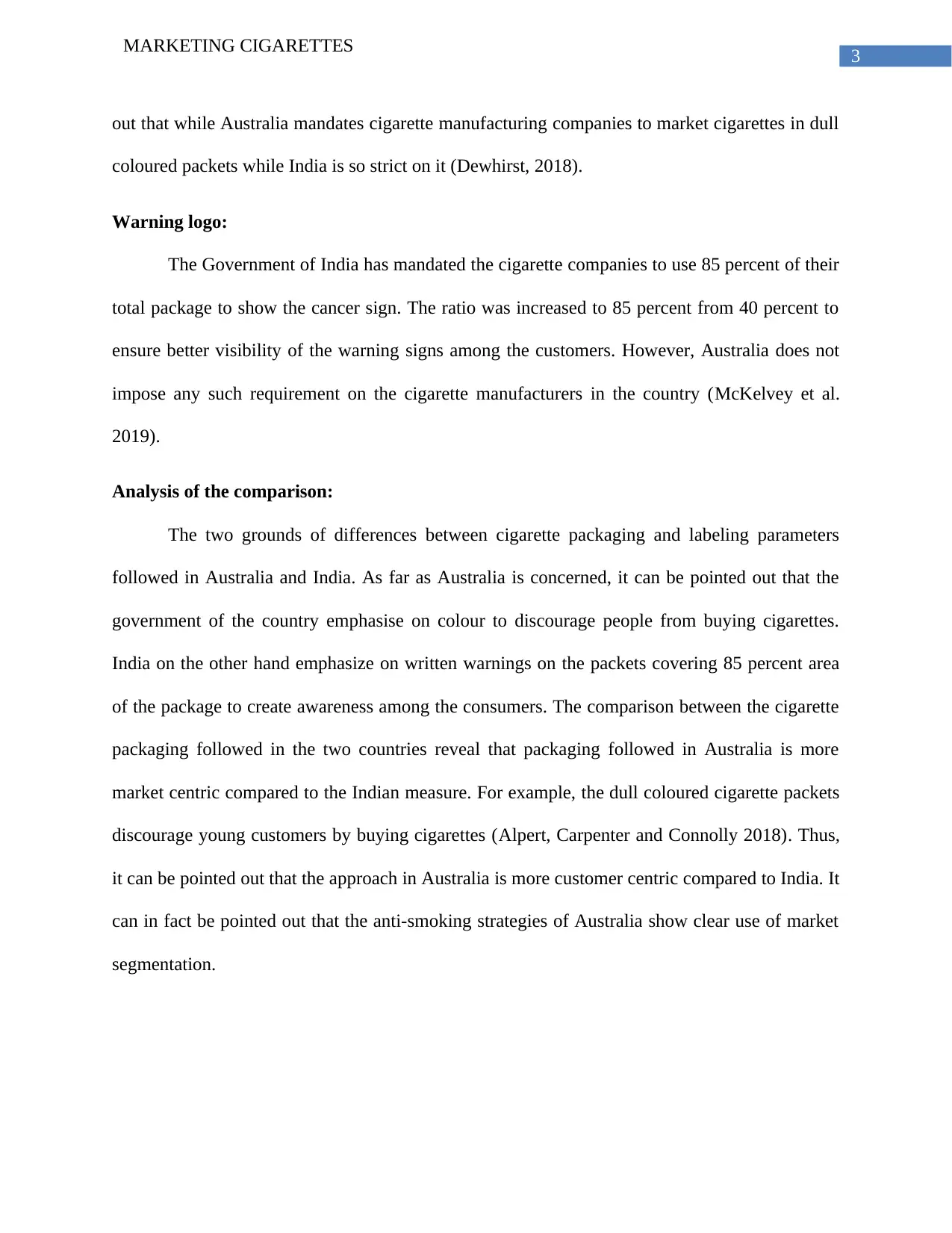
3
MARKETING CIGARETTES
out that while Australia mandates cigarette manufacturing companies to market cigarettes in dull
coloured packets while India is so strict on it (Dewhirst, 2018).
Warning logo:
The Government of India has mandated the cigarette companies to use 85 percent of their
total package to show the cancer sign. The ratio was increased to 85 percent from 40 percent to
ensure better visibility of the warning signs among the customers. However, Australia does not
impose any such requirement on the cigarette manufacturers in the country (McKelvey et al.
2019).
Analysis of the comparison:
The two grounds of differences between cigarette packaging and labeling parameters
followed in Australia and India. As far as Australia is concerned, it can be pointed out that the
government of the country emphasise on colour to discourage people from buying cigarettes.
India on the other hand emphasize on written warnings on the packets covering 85 percent area
of the package to create awareness among the consumers. The comparison between the cigarette
packaging followed in the two countries reveal that packaging followed in Australia is more
market centric compared to the Indian measure. For example, the dull coloured cigarette packets
discourage young customers by buying cigarettes (Alpert, Carpenter and Connolly 2018). Thus,
it can be pointed out that the approach in Australia is more customer centric compared to India. It
can in fact be pointed out that the anti-smoking strategies of Australia show clear use of market
segmentation.
MARKETING CIGARETTES
out that while Australia mandates cigarette manufacturing companies to market cigarettes in dull
coloured packets while India is so strict on it (Dewhirst, 2018).
Warning logo:
The Government of India has mandated the cigarette companies to use 85 percent of their
total package to show the cancer sign. The ratio was increased to 85 percent from 40 percent to
ensure better visibility of the warning signs among the customers. However, Australia does not
impose any such requirement on the cigarette manufacturers in the country (McKelvey et al.
2019).
Analysis of the comparison:
The two grounds of differences between cigarette packaging and labeling parameters
followed in Australia and India. As far as Australia is concerned, it can be pointed out that the
government of the country emphasise on colour to discourage people from buying cigarettes.
India on the other hand emphasize on written warnings on the packets covering 85 percent area
of the package to create awareness among the consumers. The comparison between the cigarette
packaging followed in the two countries reveal that packaging followed in Australia is more
market centric compared to the Indian measure. For example, the dull coloured cigarette packets
discourage young customers by buying cigarettes (Alpert, Carpenter and Connolly 2018). Thus,
it can be pointed out that the approach in Australia is more customer centric compared to India. It
can in fact be pointed out that the anti-smoking strategies of Australia show clear use of market
segmentation.
Paraphrase This Document
Need a fresh take? Get an instant paraphrase of this document with our AI Paraphraser
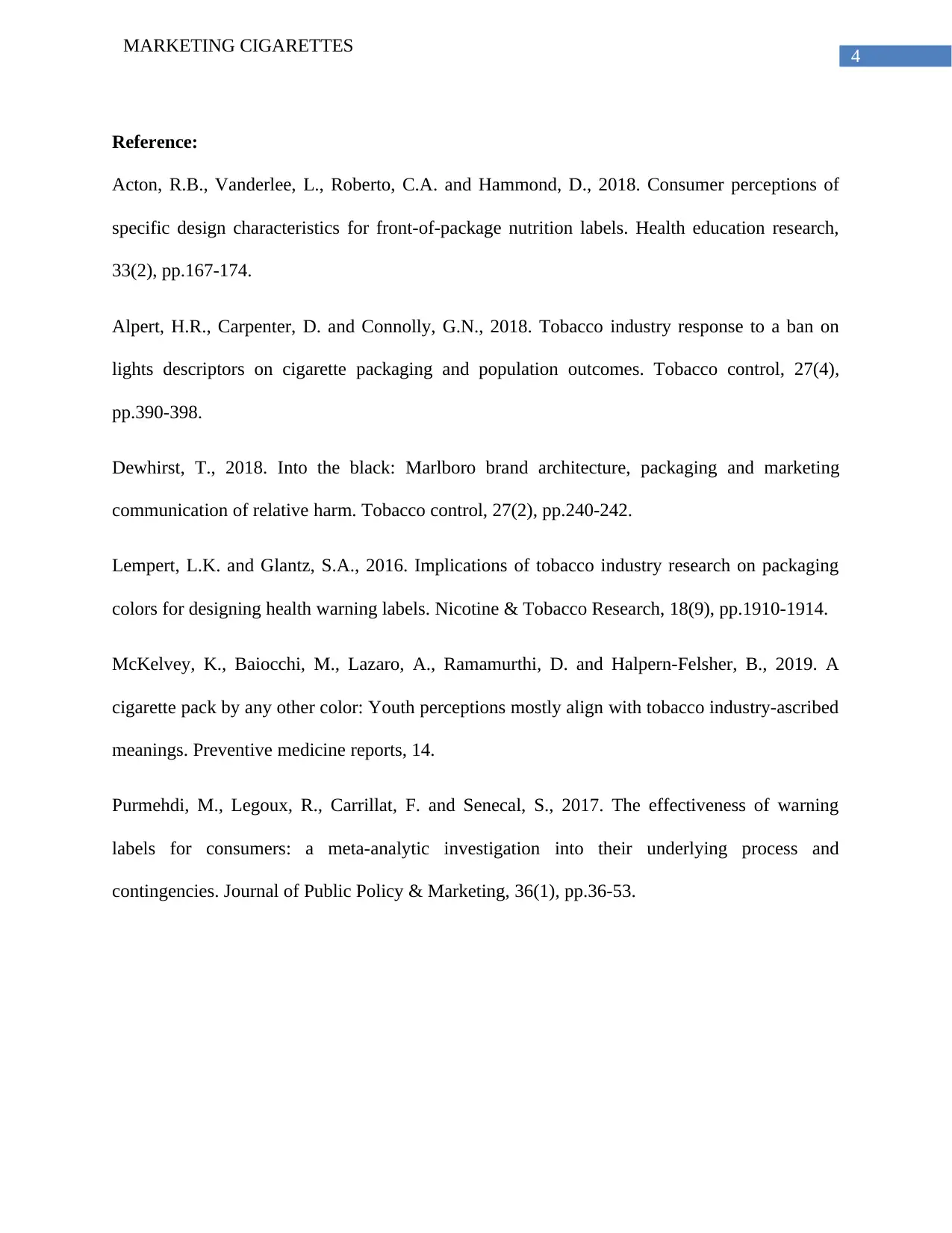
4
MARKETING CIGARETTES
Reference:
Acton, R.B., Vanderlee, L., Roberto, C.A. and Hammond, D., 2018. Consumer perceptions of
specific design characteristics for front-of-package nutrition labels. Health education research,
33(2), pp.167-174.
Alpert, H.R., Carpenter, D. and Connolly, G.N., 2018. Tobacco industry response to a ban on
lights descriptors on cigarette packaging and population outcomes. Tobacco control, 27(4),
pp.390-398.
Dewhirst, T., 2018. Into the black: Marlboro brand architecture, packaging and marketing
communication of relative harm. Tobacco control, 27(2), pp.240-242.
Lempert, L.K. and Glantz, S.A., 2016. Implications of tobacco industry research on packaging
colors for designing health warning labels. Nicotine & Tobacco Research, 18(9), pp.1910-1914.
McKelvey, K., Baiocchi, M., Lazaro, A., Ramamurthi, D. and Halpern-Felsher, B., 2019. A
cigarette pack by any other color: Youth perceptions mostly align with tobacco industry-ascribed
meanings. Preventive medicine reports, 14.
Purmehdi, M., Legoux, R., Carrillat, F. and Senecal, S., 2017. The effectiveness of warning
labels for consumers: a meta-analytic investigation into their underlying process and
contingencies. Journal of Public Policy & Marketing, 36(1), pp.36-53.
MARKETING CIGARETTES
Reference:
Acton, R.B., Vanderlee, L., Roberto, C.A. and Hammond, D., 2018. Consumer perceptions of
specific design characteristics for front-of-package nutrition labels. Health education research,
33(2), pp.167-174.
Alpert, H.R., Carpenter, D. and Connolly, G.N., 2018. Tobacco industry response to a ban on
lights descriptors on cigarette packaging and population outcomes. Tobacco control, 27(4),
pp.390-398.
Dewhirst, T., 2018. Into the black: Marlboro brand architecture, packaging and marketing
communication of relative harm. Tobacco control, 27(2), pp.240-242.
Lempert, L.K. and Glantz, S.A., 2016. Implications of tobacco industry research on packaging
colors for designing health warning labels. Nicotine & Tobacco Research, 18(9), pp.1910-1914.
McKelvey, K., Baiocchi, M., Lazaro, A., Ramamurthi, D. and Halpern-Felsher, B., 2019. A
cigarette pack by any other color: Youth perceptions mostly align with tobacco industry-ascribed
meanings. Preventive medicine reports, 14.
Purmehdi, M., Legoux, R., Carrillat, F. and Senecal, S., 2017. The effectiveness of warning
labels for consumers: a meta-analytic investigation into their underlying process and
contingencies. Journal of Public Policy & Marketing, 36(1), pp.36-53.
1 out of 5
Related Documents
Your All-in-One AI-Powered Toolkit for Academic Success.
+13062052269
info@desklib.com
Available 24*7 on WhatsApp / Email
![[object Object]](/_next/static/media/star-bottom.7253800d.svg)
Unlock your academic potential
Copyright © 2020–2025 A2Z Services. All Rights Reserved. Developed and managed by ZUCOL.


